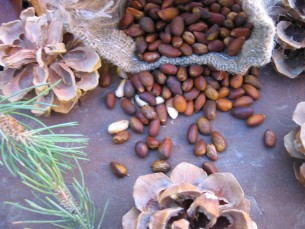
| A site for promoting the sustainable harvest of wild pinyon nuts |
 |
|
|
Our first example is about pinyon nut traditions of the Washoe people, inhabitants of the Great Basin. We will add more examples as people submit them. If you wish to contribute information about your culture's or your family's pinyon nut traditions, please contact Penny Frazier, project partner, at pinenuts@pinenut.com. Washoe Pinyon Nut Harvesting Traditions Humans have inhabited the Great Basin, which includes all of Nevada, western Utah, and small portions of southeastern Oregon, southern Idaho, and eastern California, for at least 12,000 years. Until the early 1900s the seeds of the singleleaf pinyon, Pinus monophylla, were a critical food source for the peoples who lived in this desert environment. This example describes some of the traditions surrounding pinyon nuts among the Washoe people as recounted in oral histories recorded by researchers at the University of Nevada in the 1990s. Pinyon nuts from the singleleaf pinyon can easily be picked off the ground after the cones fall. However, often the nuts are consumed by birds, insects, and small mammals before the cones are ready to drop. The Washoe and other Great Basin peoples thus developed technologies for harvesting green cones, as well as methods for removing the nuts efficiently. Harvesting and processing nuts from the singleleaf pinyon was complicated work and typically involved the entire community. For the peoples of the Great Basin, including the Washoe, the pinyon harvest was the year's most important social event, bringing together the many dispersed bands into the lowland pinyon forest. The Washoe set up camps in these forests in the early fall before the cones had fully ripened and dropped. Prior to the harvest, they held a "first fruit" celebration, showing their respect for the forest and acknowledging the sacredness of the pinyon tree. Once the harvest was in full swing, there was plenty of work for all. The men removed the green cones from the trees using tools made from large willow branches. The branches had a V-shaped hook at the end to remove the cones. As the men brought down the cones, women and children piled them into wicker baskets. When removing the cones, the men selected cones just ready to open. These green cones were usually full of pitch, making harvesting a sticky task. Women and children carried the baskets of cones back to camp for processing. They first roasted the cones by placing them near hot coals to open the scales and expose the nuts. Then they beat the cones remove the nuts. To remove the soft brown shells, the processors placed the nuts on a basketry tray along with hot coals. They tossed and swirled the nuts and coals together until the shells became hard and crisp. After placing the hard nuts on a grinding stone, they pounded the nuts lightly to remove the shells without damaging the seeds. At this stage in the roasting process, the seeds are translucent, soft, and ready to eat. However, they do not store well. To make use of the abundant nut supply, the Washoe women processed the nuts even further. They placed the nuts back in a winnowing tray, and tossing them in the air to remove the shells. After winnowing the soft nuts, they added hot coals and repeated the roasting process until the nuts were dry, hard, and dark in color. Once dried, the Washoe stored the nuts in large storage baskets for later use. Although the dried nuts can be eaten without additional processing, generally the Washoe ground them into pinyon nut flour. They then mixed the flour with water to make a thick paste, adding berries, leafy plants, and ground meat or fish to make a delicious and nutritious mush. Source: Tah-Gum, The Washoe Pine-Nut Harvest. 1999. Produced by Tom King. University of Nevada Oral History Program. Stories from the Great Pinon Nut Giveaway Contest As part of its Great Pinon Nut Giveaway Contest this fall, Goods from the Woods has collected many stories of pinon nut harvesting. Check out the story webpage and enjoy tales about pinon nut harvesting from the 1930s to the present day. http://www/pinenut.com/pinon_stories.html
|
 |
|